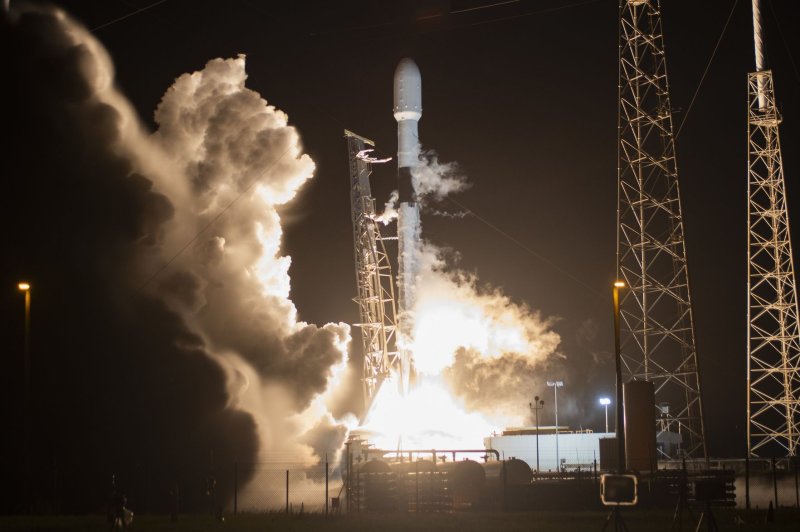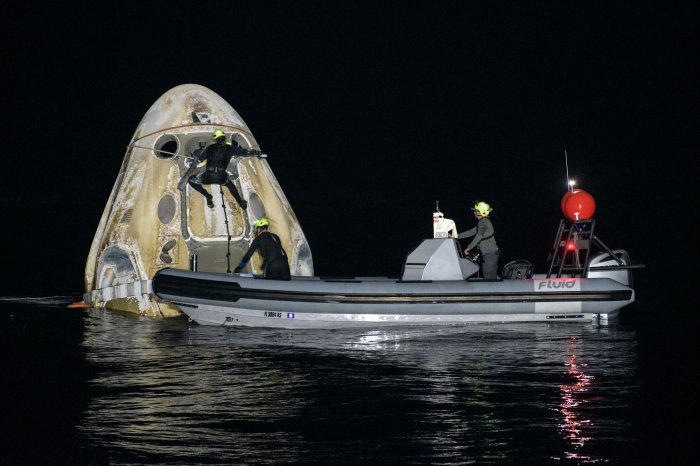1 of 3 | SpaceX plans to launch Starlink satellite missions on Thursday and Friday from Florida, similar to the launch shown here in June. File Photo by Joe Marino/UPI |
License Photo
ORLANDO, Fla., Feb. 3 (UPI) -- A plan by Elon Musk's SpaceX to launch two Starlink satellite missions from Florida on Thursday fell through, and the company now plans to send two Falcon 9 rockets aloft on consecutive days.
The first launch is planned for 1:19 a.m. EST Thursday from Complex 40 at Cape Canaveral Space Force Station, followed by another Friday at 5:14 a.m. EST from Complex 39A at Kennedy Space Center.
SpaceX said on Twitter it had moved one of the launches to Friday to allow additional time for "pre-launch checks."
The U.S. Space Force approved launching twice in one day, according to a post on the official Twitter account of the branch's 45th Space Wing. That would have been the first time since 1966 for such a feat.
"Those previous missions were Gemini 12 and Atlas Agena, which lifted off 99 minutes apart from each other," according to the tweet.
Gemini 12 carried astronauts Buzz Aldrin and James Lovell Jr. for the final manned mission before Apollo launches began.
Whenever they launch, each Falcon 9 rocket is prepared and topped with 60 of the company's own Starlink communications satellites for trips to low-Earth orbit.
As usual, SpaceX plans to host live broadcasts for each mission, which normally begin 10 to 15 minutes before liftoff time.
The weather on Thursday morning will be nearly ideal for a launch, according to the Space Force. Conditions in the Atlantic Ocean, where SpaceX intends to recover the first-stage booster, are mostly favorable. The weather Friday should be similar.
The Starlink launches are planned as SpaceX has seen more launch activity than ever over the past 12 months. The California-based company plans dozens of more launches for 2021, as it builds out the Starlink broadband communications constellation in space -- already consisting of about 1,000 spacecraft.
The company has reused a Falcon 9 first-stage booster seven times, a record for the industry. The boosters are designed to fly 10 times.
The company collects valuable data as it launches more often and pushes the limits of reusability, said Seetha Raghavan, a professor of aerospace engineering at the University of Central Florida.
"While experience will be beneficial to constantly improve safety protocols, tests and inspections must match the increased pace of launch to minimize risk," Raghavan said.
Data from such tests are "extremely valuable in understanding the high thermal, mechanical and environmental impact experienced by the structures and materials," she said.
Meanwhile, SpaceX continues to develop its next big rocket -- Starship. SpaceX's fiery test flight Tuesday in Texas of a Starship prototype saw the vehicle fly to over 6 miles high, only to descend into a fireball as one of the three Raptor engines appeared not to reignite.
Support teams work around the SpaceX Crew Dragon Resilience spacecraft shortly after it landed with NASA astronauts Mike Hopkins, Shannon Walker and Victor Glover and Japan Aerospace Exploration Agency astronaut Soichi Noguchi aboard in the Gulf of Mexico off Panama City, Fla., on Sunday. Photo by Bill Ingalls/NASA |
License Photo
















